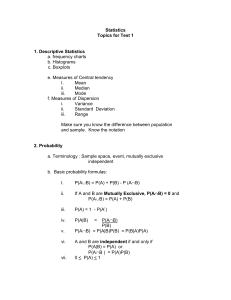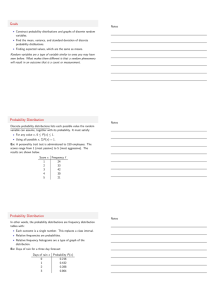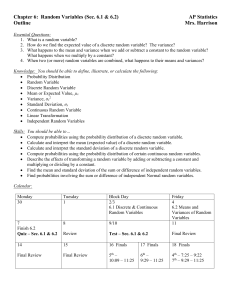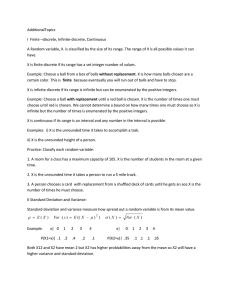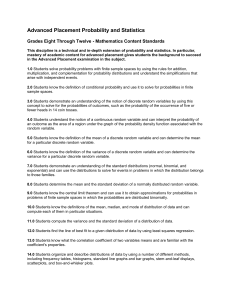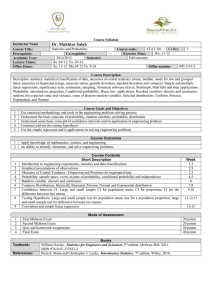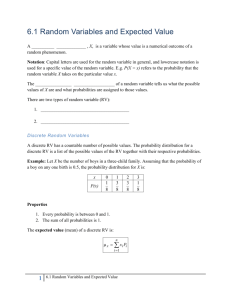Mean of Discrete Random Variables
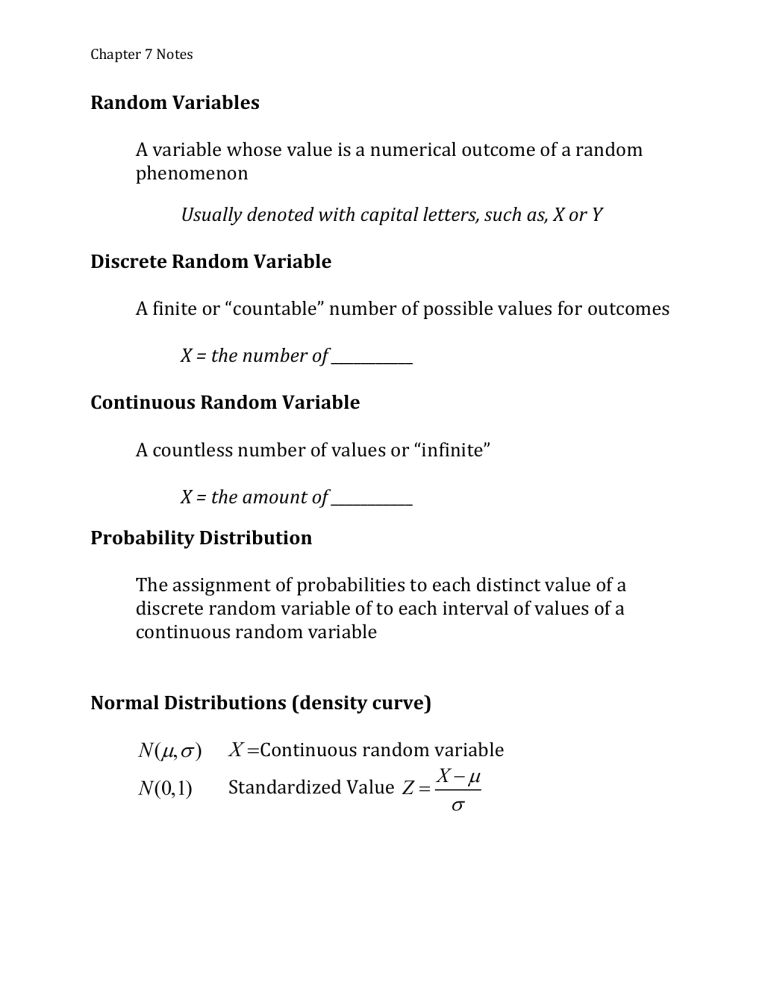
Chapter 7 Notes
Random Variables
A variable whose value is a numerical outcome of a random phenomenon
Usually denoted with capital letters, such as, X or Y
Discrete Random Variable
A finite or “countable” number of possible values for outcomes
X = the number of ___________
Continuous Random Variable
A countless number of values or “infinite”
X = the amount of ___________
Probability Distribution
The assignment of probabilities to each distinct value of a discrete random variable of to each interval of values of a continuous random variable
Normal Distributions (density curve)
N
N
( m
, s
(0,1)
) X
= Continuous random variable
Standardized Value
Z
=
X
s m
Chapter 7 Notes
Mean of Discrete Random Variables
The average of all possible values of X with consideration of the fact that not all outcomes need be equally likely.
is an ordinary average.
is the mean of a probability distribution
The mean of the random variable X is called the
expected value of X.
The mean of any discrete random variable is the weighted average using the probability of each outcome.
Value of X: x
1
Probability: p
1 x
2 p
2 x
3
. . .
x k p
3
. . . p k m x
= x
1 p
1
+ x
2 p
2
+
...
+ x k p k
S x i p i
The distribution of grades for WHS Statistics CP class is given below. Find the expected value for the data.
Grade:
Probability:
0
0.01
1
0.03
2
0.15
3
0.38
4
0.43
Chapter 7 Notes
Variance of a Discrete Random Variables
The variance and the standard deviation are measures of the spread that accompany the choice of the mean to measure center.
Variance s
2 x
Standard Deviation s x
(the square root of the variance)
Value of X: x
1
Probability: p
1 s x
2 =
( x
1
m x
)
2 p
1
+
( x
2
m x
)
2 x
2 p
2 p
2
+
...
+
( x k x
3
. . .
p
3
. . .
m x
)
2 p k x k p k
S
( x i
m x
) 2 p i
June is a sales associate at a large auto dealership. She motivates herself by using probability estimates of her sales. For a sunny
Saturday in April, she estimates her car sales as follows:
Cars sold: 0
Probability: 0.3
1
0.4
2
0.2
3
0.1
Find the standard deviation for cars sold on this sunny day in April.
Chapter 7 Notes
The Law of Large Numbers
Draw independent observations at random from any population with finite mean estimate mean m
.
Decide how accurately you would like to m
.
As the number of observations drawn increases, the x
of the observed values eventually approaches the mean m of the population as closely as you specified and then stays that close.
Basically:
The average results of many independent observations are always stable and predictable.
As the number of trials of a random process increases, the percentage difference between the expected and actual values goes to zero.
Our intuition doesn’t do a good job of distinguishing random behavior from systematic influences. We need statistical inference to supplement exploratory analysis of data to verify that what we see in the data is more than a random pattern.
The goal of statistics is to infer (conclude, make predictions) about populations based on sample data.
“Statistically unusual” - data that falls more than 2 standard deviations away from the mean .
Chapter 7 Notes
An opinion poll asks an SRS of 1500 American adults what they consider to be the most serious problem facing our schools.
Suppose that if we ask all adults this question, 30% would say
“drugs.” If the normal distribution N(0.3, 0.0118) is used, what is the probability that the poll result differs from the truth about the population by more than 2%?
Chapter 7 Notes
